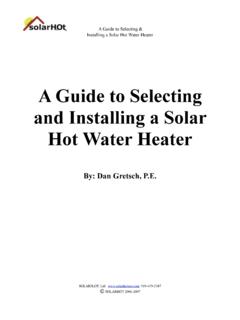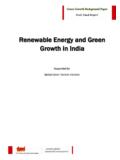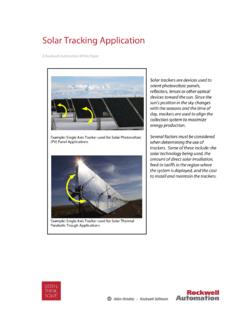Transcription of EUROTROUGH - Parabolic Trough Collector …
1 11th SolarPACES International Symposium on concentrated solar Power and Chemical energy Technologies, Sept 4-6, 2002, Zurich, Switzerland 1 EUROTROUGH - Parabolic Trough Collector Developed for Cost Efficient solar Power Generation Michael Geyer b, Eckhard L pfert f, Rafael Osuna a, Antonio Esteban a, Wolfgang Schiel c, Axel Schweitzer c, Eduardo Zarza e, Paul Nava b, Josef Langenkamp b, Eli Mandelberg d a INABENSA Instalaciones Abengoa , Avenida de la Buhaira 2, E-41018 Sevilla, Spain b FLABEG solar International GmbH, M hlengasse 7, D-50667 K ln, Germany c Schlaich Bergermann und Partner, , D-70178 Stuttgart, Germany d SOLEL solar Systems, Box 811, Beit Shemesh 99107, Israel e CIEMAT Plataforma solar , Apartado 22, E-04200 Tabernas (Almer a), Spain f DLR Plataforma solar , Apartado 39, E-04200 Tabernas (Almer a), Spain Abstract - The high-performance EUROTROUGH Parabolic Trough Collector models ET100 and ET150 have been developed for the utility scale generation of solar steam for process heat applications and solar power generation.
2 With corresponding receiver tubes they can be used in combination with various heat transfer fluids in large solar fields. With an optical concentration of 82:1 operating temperatures over 500 C may be reached. The ET100 and ET150 structure geometry has included wind channel and finite element method validation and is compatible with the standard receiver tubes and mirror panels of the market. The loop and field concept is also fully compatible with the proven solar field technology of the successful solar Electric Generating Systems (SEGS) in California and can be integrated to field sizes for up to 200 MWel solar plants. The Collector modules have been fully qualified in the years 2000 2002 with a synthetic heat transfer fluid for 395 C operation at the Plataforma solar in Almeria with independent performance test certificates from the research laboratories. 14% solar field cost reduction are anticipated due to weight reduction and Collector extension to 150 meters.
3 A 50 MW solar power plant with 549 000 m2 of EUROTROUGH collectors and 9h-thermal storage is projected for South Spain. 1. Technical Features Figure 1: Working Principle of the EUROTROUGH Collector Figure 1 shows the working principle of the EUROTROUGH Collector at the Plataforma solar . By tracking the sun from sunrise to sunset, the Parabolic EUROTROUGH collectors concentrate the sun s radiation with their Parabolic mirror facets on the absorber tubes along their focal line. Through these absorber tube circulates a heat transfer fluid (HTF), usually synthetic oil, which is heated to a temperature of nearly 400 C. 11th SolarPACES International Symposium on concentrated solar Power and Chemical energy Technologies, Sept 4-6, 2002, Zurich, Switzerland 2 EUROTROUGH Model ET100 ET150 Focal Length m m Absorber Radius cm cm Aperture Width m m Aperture Area 545 m m Collector Length m m Number of Modules per Drive 8 12 Number of Glass Facets 224 336 Number of Absorber Tubes ( m) 24 36 Mirror reflectivity 94% 94% Weight of steel structure and pylons, per m2 aperture area kg kg Table 1: Main characteristic parameters of EUROTROUGH 100 m and 150 m The EUROTROUGH Collector models are made up of identical 12 m long Collector modules.
4 Each module comprises 28 Parabolic mirror panels - 7 along the horizontal axis between pylons and 4 in a vertical cross-section. Each mirror is supported on the structure at four points on its backside. This permits the glass to bend within the range of its flexibility without effect on the focal point. The 100 m long ET100 has 8 Collector modules and an aperture area of 545 m , the 150 m long ET150 has 12 Collector modules and an aperture area of m . Detailed wind tunnel tests have been conducted for obtaining a reliable database for the expected wind loads at different locations in the Collector field. Bending and torsion forces have been determined in these experiments. Horizontal forces and pitching moments have been evaluated for different wind speed and direction, different Collector positions in the field and various elevations of the Collector . Existing Regular Version Torque Tube Design A Torque Box Design A Bending Load Torsion Load Figure 2: Concentrator deformation analysis for different support structures Detailed FEM investigations (see Figure 2) on the structural behaviour under various load cases (dead load, wind loads for a range of pitching angles of the Collector and wind directions) for alternate designs, complex computer modelling and ray tracing were performed to obtain the best possible relationship of optical accuracy and Collector cost.
5 11th SolarPACES International Symposium on concentrated solar Power and Chemical energy Technologies, Sept 4-6, 2002, Zurich, Switzerland 3 Figure 3: Computer Model of the EUROTROUGH Collector with Torque-Box Design Based on these studies a so-called torque-box design has been selected for the EUROTROUGH , with less weight and less deformations of the Collector structure due to dead weight and wind loading than the reference designs (LS-2 torque tube or the LS-3 V-truss design, both commercial in the Californian plants). This reduces torsion and bending of the structure during operation and results in increased optical performance and wind resistance. The weight of the steel structure has been reduced about 14% as compared to the available design of the LS-3 Collector . The central element of the box design is a 12-m long steel space-frame structure having a squared cross section that holds the support arms for the Parabolic mirror facets.
6 The torque box is built out of only 4 different steel parts. This leads to easy manufacturing, and decreases required efforts and thus cost for assembling on site. Transportation volume has been optimized for maximum packing. The structural deformation of the new design is considerably less than in the previous design (LS-3), which results in a better performance of the Collector . Thus the spillage during operation can be reduced by approximately 2-10 percentage points. abcde Figure 4: EUROTROUGH Collector element consisting out of (a) 2 endplates; (b) 4 simple steel frames screwed to a torque box; (c) 3 absorber tube supports; (d) 28 cantilever arms and (e) 28 mirror facets. The design utilizes mirror supports that make use of the glass facets as static structural elements, but at the same time reduce the forces on the glass sheets by a factor of three. This promises less glass 11th SolarPACES International Symposium on concentrated solar Power and Chemical energy Technologies, Sept 4-6, 2002, Zurich, Switzerland 4breakage with the highest wind speeds.
7 Absorber tube supports were designed such to reduce the breakage risk and to ease mirror cleaning in comparison to the LS-3 Collector . The accuracy of the concentrator is achieved by a combination of prefabrication with jig mounting on site. The majority of the structural parts are produced with steel construction tolerances. The accuracy for the mirror supports is introduced with the glass brackets on each of the cantilever arms. This concept allows minimum assembly manpower and cost in series fabrication of solar fields. The ET100 and ET150 are tracked with the sun during operation along their long axis with a hydraulic drive. The drive system consists out of two hydraulic cylinders mounted on the central drive pylon. From a control box mounted on the drive pylon signal and power lines lead to the hydraulic unit, the rotational encoder, limit switches and temperature sensors. The tracking system developed for the ET100 and ET150 on the Plataforma solar is based on 'virtual' tracking.
8 The traditional sun-tracking unit with sensors that detect the position of the sun has been replaced by a system based on calculation of the sun position using a mathematical algorithm [2]. The unit is implemented in EUROTROUGH with a 13-bit optical angular encoder (resolution of mrad) mechanically coupled to the rotation axis of the Collector . Comparing both sun and Collector axes positions by an electronic device, an order is sent to the drive system, inducing tracking. The latest version of the solar coordinates calculation algorithm was checked against the Multiyear Interactive Computer Almanac (MICA), a software product of the United States Naval Observatory. Errors in longitude and/or latitude of the site below 10 km do not provoke a significant positioning error, if the Parabolic Trough collectors are correctly aligned. Following cost reduction potentials have been exploited: 1.
9 Cost reduction by simplification of the design: less different profiles, parts, better transportation; assembly concept; cost reduction by weight reduction of the structure; frame work structure, closed profiles, corrosion protection; finite element method for structural design calculations; wind analyses for proper definition of the load cases 2. Cost reduction by improvement of the optical performance of the Collector : rigid support structure --> frame work torque box; manufacturing, assembly accuracy 3. Cost reduction achieved in additional steps: possible tilt of the Collector and extension of Collector length per drive unit (ET150). The anticipated overall cost reduction for the solar field is 14% for ET150 collectors. Additional reduction of solar electricity cost will be achieved by the higher annual performance due to improved optical parameters. 2. Performance Tests were carried out and evaluated on thermal performance and structural torsion under external load.
10 The EUROTROUGH Collector showed a performance of 3 % points higher than LS-2 reported by Sandia, see Figure 5. Because of the fact that the efficiency definitions used by Sandia for the LS-2 Collector evaluation [5] are the same as used for the EUROTROUGH , both Collector types can be compared directly. The measured specific thermal losses of the EUROTROUGH and the LS-2 Collector are almost identical, which is explained by the use of the same heat collection element as absorber (Solel HCE tubes with Cermet coating). That leads to a similar thermal efficiency of both collectors. The EUROTROUGH Collector behavior for incident angles of more than 30 is more efficient than the LS-2 Collector . This is due to the larger Collector module, higher geometric precision of the parabola, and less shading due to improved absorber support design. Collector torsion under load was analyzed from the measurements of the angular encoders of each Collector pylon.







